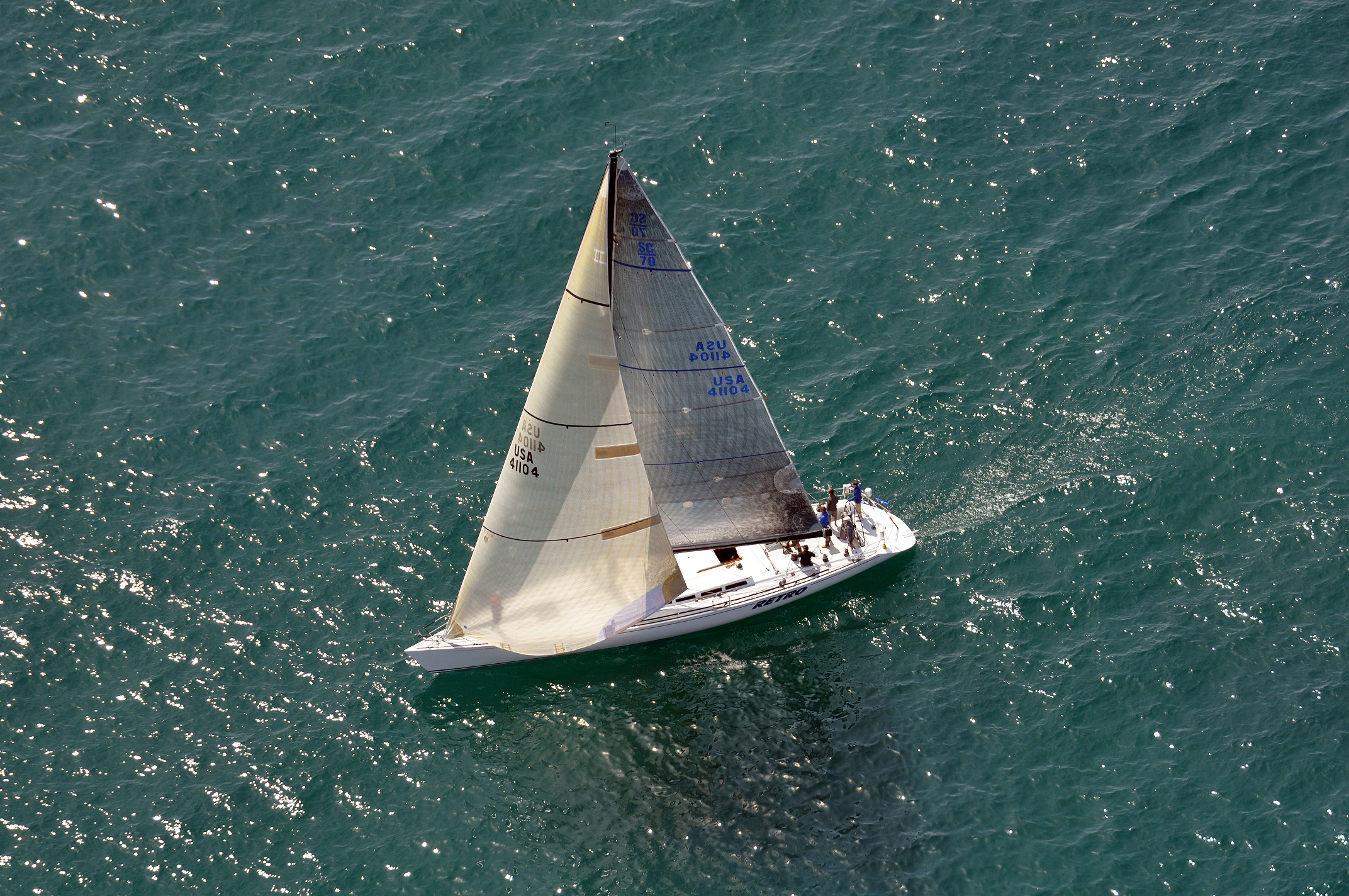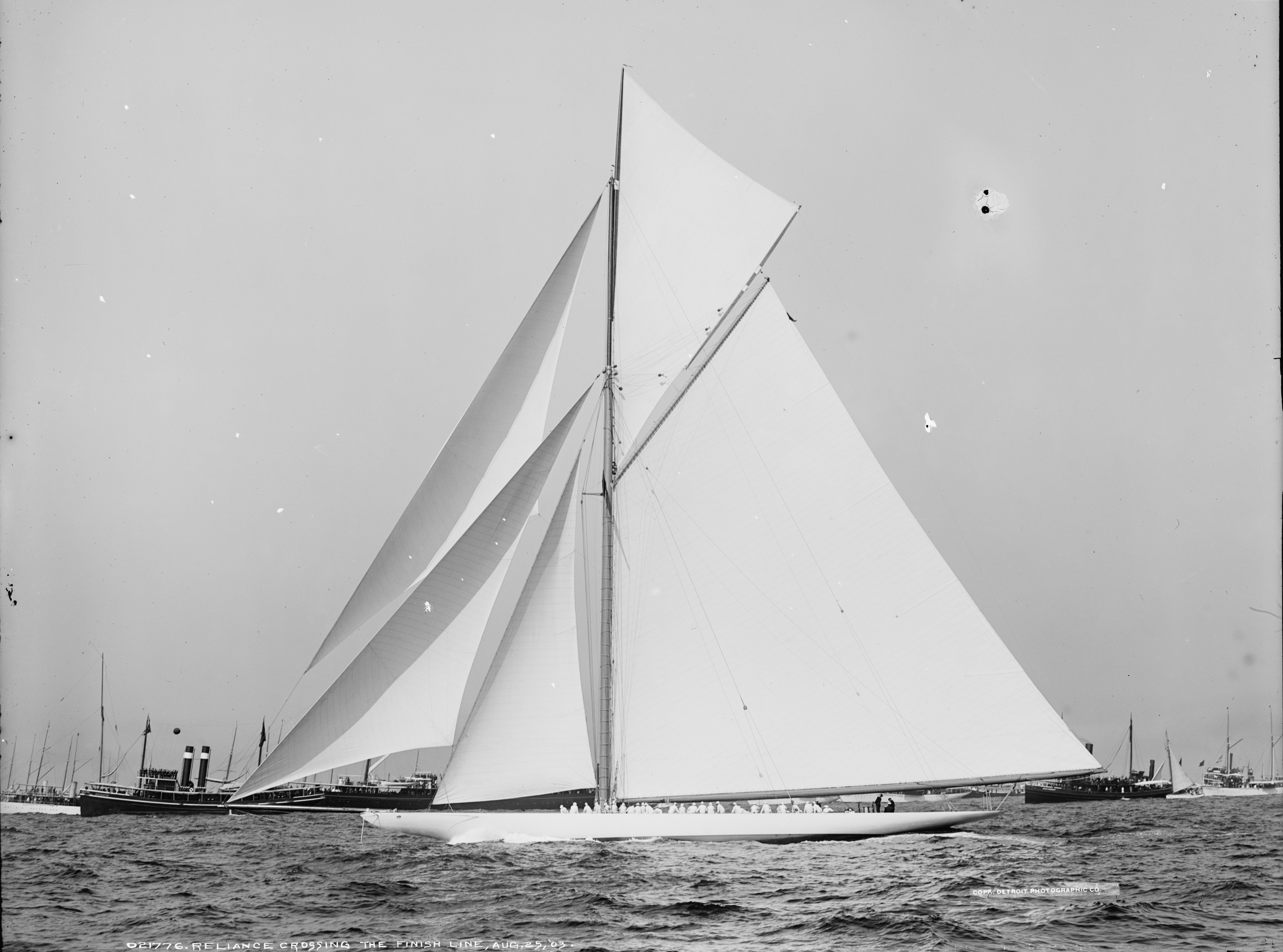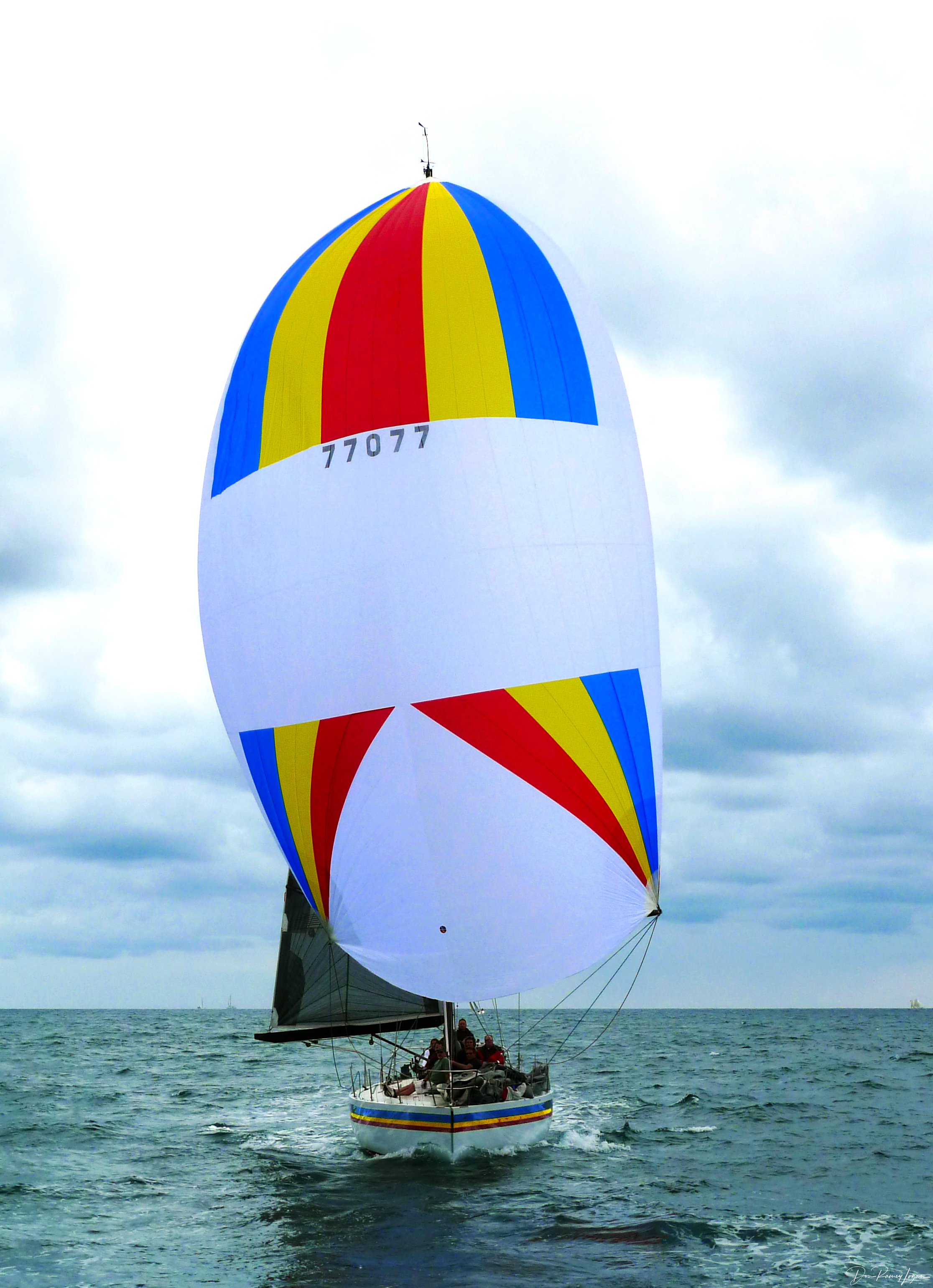|
Mainsail
A mainsail is a sail rigged on the main mast of a sailing vessel. * On a square rigged vessel, it is the lowest and largest sail on the main mast. * On a fore-and-aft rigged vessel, it is the sail rigged aft of the main mast. The sail's foot is normally attached to a boom. (In extremely heavy weather, the mainsail may be lowered, and a much smaller trysail hoisted in its place). Historical fore-and-aft rigs used a four-sided gaff rigged mainsail, sometimes setting a gaff topsail above it. Whereas once the mainsail was typically the largest sail, today the mainsail may be smaller than the jib or genoa; Prout catamarans typically have a mainmast stepped further aft than in a standard sloop, so that the mainsail is much smaller than the foresail. Bermuda rig The modern Bermuda rig uses a triangular mainsail aft of the mast, closely coordinated with a jib for sailing upwind. A large overlapping jib or genoa Genoa ( ; it, Genova ; lij, Zêna ). is the capital of ... [...More Info...] [...Related Items...] OR: [Wikipedia] [Google] [Baidu] |
Mast-aft Rig
A mast-aft rig is a sailboat sail-plan that uses a single mast set in the aft half of the hull. The mast supports fore-sails that may consist of a single jib, multiple staysails, or a crab claw sail. The mainsail is either small or completely absent. Mast-aft rigs are uncommon, but are found on a few custom, and production sailboats. Comparison to other single mast rigs Many mast-aft rigs utilize a small mainsail and multiple staysails that can resemble some cutter rigs. A cutter is a single masted vessel, differentiated from a sloop either by the number of staysails, with a sloop having one and a cutter more than one, or by the position of the mast, with a cutter's mast being located between 50% and 70% of the way from the aft to the front of the sailplan, and a sloop's mast being located forward of the 70% mark. A mast-aft rig could, based on headsail count, be considered a variation of the sloop or cutter, or, based on mast position, a unique rig. Advantages In the typical ... [...More Info...] [...Related Items...] OR: [Wikipedia] [Google] [Baidu] |
Genoa (sail)
A genoa sail is a type of large jib or staysail that extends past the mast and so overlaps the main sail when viewed from the side, sometimes eliminating it. It was originally called an "overlapping jib" and later a genoa jib. It is used on single-masted sloops and twin-masted boats such as yawls and ketches. Its larger surface area increases the speed of the craft in light to moderate winds; in high wind, a smaller jib is usually substituted, and downwind a spinnaker may be used. Definition The term ''jib'' is the generic term for any of an assortment of ''headsails''. The term ''genoa'' (or genny) refers to a type of jib that is larger than the 100% foretriangle, which is the triangular area formed by the point at which the stay intersects the mast, and deck or bowsprit, and the line where the mast intersects deck at the rail. Colloquially the term is sometimes used interchangeably with ''jib''. A working jib is no larger than the 100% foretriangle. A genoa is larger, with ... [...More Info...] [...Related Items...] OR: [Wikipedia] [Google] [Baidu] |
Bermuda Rig
A Bermuda rig, Bermudian rig, or Marconi rig is a configuration of mast and rigging for a type of sailboat and is the typical configuration for most modern sailboats. This configuration was developed in Bermuda in the 1600s; the term ''Marconi'', a reference to the inventor of the radio, Guglielmo Marconi, became associated with this configuration in the early 1900s because the wires that stabilize the mast of a Bermuda rig reminded observers of the wires on early radio masts. Description The rig consists of a triangular sail set aft of the mast with its mainsail raised to the top of the mast; its luff runs down the mast and is normally attached to it for its entire length; its tack is attached at the base of the mast; its foot (in modern versions of the rig) controlled by a boom; and its clew attached to the aft end of the boom, which is controlled by its sheet.''Boats, Boffins and Bowlines: The Stories of Sailing Inventors and Innovations'', by George Drower. The Histor ... [...More Info...] [...Related Items...] OR: [Wikipedia] [Google] [Baidu] |
Gaff Rig
Gaff rig is a sailing rig (configuration of sails, mast and stays) in which the sail is four-cornered, fore-and-aft rigged, controlled at its peak and, usually, its entire head by a spar (pole) called the ''gaff''. Because of the size and shape of the sail, a gaff rig will have running backstays rather than permanent backstays. The gaff enables a fore and aft sail to be four sided, rather than triangular. A gaff rig typically carries 25 percent more sail than an equivalent Bermudian rig for a given hull design. A sail hoisted from a gaff is called a gaff-rigged (or, less commonly, gaff rigged or gaffrigged) sail. Description Gaff rig remains the most popular fore-aft rig for schooner and barquentine mainsails and other course sails, and spanker sails on a square rigged vessel are always gaff rigged. On other rigs, particularly the sloop, ketch and yawl, gaff rigged sails were once common but have now been largely replaced by the Bermuda rig sail, which, in addition ... [...More Info...] [...Related Items...] OR: [Wikipedia] [Google] [Baidu] |
Sailing
Sailing employs the wind—acting on sails, wingsails or kites—to propel a craft on the surface of the ''water'' ( sailing ship, sailboat, raft, windsurfer, or kitesurfer), on ''ice'' ( iceboat) or on ''land'' ( land yacht) over a chosen course, which is often part of a larger plan of navigation. From prehistory until the second half of the 19th century, sailing craft were the primary means of maritime trade and transportation; exploration across the seas and oceans was reliant on sail for anything other than the shortest distances. Naval power in this period used sail to varying degrees depending on the current technology, culminating in the gun-armed sailing warships of the Age of Sail. Sail was slowly replaced by steam as the method of propulsion for ships over the latter part of the 19th century – seeing a gradual improvement in the technology of steam through a number of stepwise developments. Steam allowed scheduled services that ran at higher average speeds tha ... [...More Info...] [...Related Items...] OR: [Wikipedia] [Google] [Baidu] |
Spinnaker
A spinnaker is a sail designed specifically for sailing off the wind on courses between a reach (wind at 90° to the course) to downwind (course in the same direction as the wind). Spinnakers are constructed of lightweight fabric, usually nylon, and are often brightly colored. They may be designed to perform best as either a reaching or a running spinnaker, by the shaping of the panels and seams. They are attached at only three points and said to be ''flown''. Nomenclature Informal names for a spinnaker are ''kite'' or ''chute'' (owing to their resemblance to a parachute in both construction and appearance). Boats may have more than one spinnaker, differentiated by a letter to indicate symmetric (S) or asymmetric (A) and a number to indicate size (with higher numbers indicating smaller size), e.g. ''A1'' would be a large asymmetric sail and ''S3'' would be a smaller symmetric sail. Operation A spinnaker is used for sailing with the direction of the wind. Symmetrical ... [...More Info...] [...Related Items...] OR: [Wikipedia] [Google] [Baidu] |
Mast (sailing)
The mast of a sailing vessel is a tall spar, or arrangement of spars, erected more or less vertically on the centre-line of a ship or boat. Its purposes include carrying sails, spars, and derricks, and giving necessary height to a navigation light, look-out position, signal yard, control position, radio aerial or signal lamp. Large ships have several masts, with the size and configuration depending on the style of ship. Nearly all sailing masts are guyed. Until the mid-19th century, all vessels' masts were made of wood formed from a single or several pieces of timber which typically consisted of the trunk of a conifer tree. From the 16th century, vessels were often built of a size requiring masts taller and thicker than could be made from single tree trunks. On these larger vessels, to achieve the required height, the masts were built from up to four sections (also called masts). From lowest to highest, these were called: lower, top, topgallant, and royal masts. Giving t ... [...More Info...] [...Related Items...] OR: [Wikipedia] [Google] [Baidu] |
Reefing
Reefing reduces the area of a sail, usually by folding or rolling one edge of the canvas in on itself and attaching the unused portion to a spar or a stay, as the primary measure to preserve a sailing vessel's stability in strong winds. Restoring full sail area is termed ''shaking out'' a reef. Whereas fore-and-aft rigged vessels store the unused portion of the sail on a boom, below the sail, square-rigged vessels stow the unused portion on a spar, above the sail. Reefing may occur by rolling the sail around its luff or foot, either on a rotating stay or within a spar. Fore-and-aft rigs Sails may have built-in alternative attachment points that allow their area to be reduced. In a mainsail, pairs of grommets, called reefing tacks, reefing clews, or reefing cringles may be installed in the sail; a cruising boat will typically have two to three pairs. Pulling these points down to the boom forms a new tack and clew, reducing the sail's area. Using the pair of grommets closest ... [...More Info...] [...Related Items...] OR: [Wikipedia] [Google] [Baidu] |
Square Rig
Square rig is a generic type of sail and rigging arrangement in which the primary driving sails are carried on horizontal spars which are perpendicular, or square, to the keel of the vessel and to the masts. These spars are called '' yards'' and their tips, outside the lifts, are called the '' yardarms.'' A ship mainly rigged so is called a square-rigger. The square rig is aerodynamically the most efficient running rig (i.e., sailing downwind), and stayed popular on ocean-going sailing ships until the end of the Age of Sail. The last commercial sailing ships, windjammers, were usually square-rigged four-masted barques. History The oldest archaeological evidence of use of a square-rig on a vessel is an image on a clay disk from Mesopotamia from 5000 BC. Single sail square rigs were used by the ancient Egyptians, the Phoenicians, the Greeks, the Romans, and the Celts. Later the Scandinavians, the Germanic peoples, and the Slavs adopted the single square-rigged sail, wit ... [...More Info...] [...Related Items...] OR: [Wikipedia] [Google] [Baidu] |
Trysail
A trysail (also known as a spencer) is a small triangular or square fore-and-aft rigged sail hoisted in place of a larger mainsail when winds are very high. The trysail provides enough thrust to maintain control of the ship, e.g. to avoid ship damage, and to keep the bow to the wind. It is hoisted abaft (i.e., directly behind) the mainmast (taking the place of the much larger mainsail) or, on a brig, abaft the foremast. A trysail is analogous to a storm jib. Royal Navy usage In the Royal Navy in the late nineteenth century, the term 'trysail' came to denote the main fore-and-aft sail on any mast. This included the mainsail of the 'great brig' HMS ''Temeraire'', the largest fore-and-aft sail ever used by a warship. Naval trysails were usually gaff-rigged and 'loose-footed', with a spar along the head but no boom, and small auxiliary trysails continued in intermittent use into the 1920s for seakeeping Seakeeping ability or seaworthiness is a measure of how well-suited ... [...More Info...] [...Related Items...] OR: [Wikipedia] [Google] [Baidu] |
Sail Batten
On sailboats, a sail batten is a flexible insert in a sail, parallel to the direction of wind flow, that helps shape its qualities as an airfoil. Battens are long, thin strips of material, historically wooden but today usually fiberglass, vinyl, or carbon fiber, used to support the roach of a sail. They are also used on tall ships to form the ladders up the shrouds in a fashion similar to ratlines. History A '' junk'' is an ancient Chinese sailing ship design that is still in use today. Junks were used as seagoing vessels as early as the 2nd century AD and developed rapidly during the Song Dynasty (960–1279). Their rigs featured full-length battens that facilitated short-handed sail handling, including reefing. Applications in sails The most common use of sail battens is in the roach of a mainsail. The batten extends the leech past the line that runs from the head and the clew of the sail to create a wider sail towards the top. Cruising sailboat A sailboat or sa ... [...More Info...] [...Related Items...] OR: [Wikipedia] [Google] [Baidu] |





.jpg)
.png)

